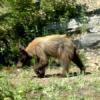The limestone steps of that pyramid scatter sound. Were the tourists clapping? The sound travels through the air, on the surface and through the body of the pyramid. Limestone resonates at 35---45Hz. The Earth vibrates, we vibrate. A simple field test for vibrations passing to your camera is to put the camera on a tripod. Slide a 'bubble level' accessory into the hot shoe and watch the bubble dance.
There are 2 types of Sasquatch images: published and unpublished. We can only guess about the unpublished images. There are images from 1967 that are good enough to be the Holy Grail of this site. Kodak 16mm camera with spring motor driven film advance and rotary cinema type shutter with a fixed focal length lens having very good glass and coatings. " Anomalies of light" were dealt with. The camera did not have any electronics / batteries. No light meter. The critical design feature was to hold the film flat during exposure.
The cause of blurred images is a rabbit hole. Most people can not hold a camera correctly. Then there are auto-focus and image stabilization. Auto focus takes some milliseconds for searching. If the shutter is activated during the searching, unhappiness usually results. Auto-focus and image stabilization move optical components and use battery power. Turn them off and focus to a hyperfocal distance.
My lenses with auto-focus use ultrasonic motors. Ultrasonic vibrations cause the motor elements to move. Great. My lenses work at 30kHz and in theory should not be affected by sound waves projected by our cousins. I prefer to shut off auto-focus and image stabilization to conserve battery power. Our contemporary camera equipment emits infrasonic, sonic and ultrasonic noise.



